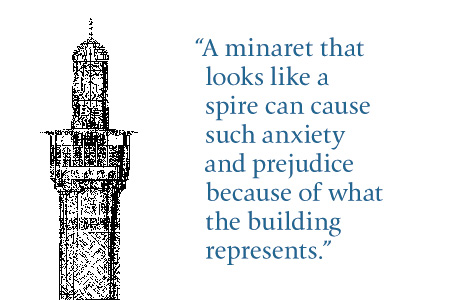
The Meaning of Minarets
Issue 65 February 2010
Following the decision by Swiss authorities to ban minarets, what is it that causes such fear?
What is the difference between a church spire and a mosque minaret? This is a question that has pre-occupied me since late 2009, when the Swiss voted in a referendum to ban minarets, carrying the motion by 57.5%.
The ban has provoked controversy, and it is likely to be taken to appeal on the grounds of being a violation of religious freedom and expression. Church spires are remarkably similar in size and shape to minarets, and Switzerland has plenty of the former. Yet the population invests different interpretations to the two, even though the stone and mortar are very similar. What is the meaning we ascribe to such materials, and what is it that gives them their different meanings?
Given the political climate and increasingly strong anti-Muslim sentiment, this difference in reaction to minarets and spires comes as no surprise. It is one piece of a jigsaw puzzle of seemingly small and disparate trends: proposals to ban the niqab and the hijab; the pride in calling yourself ‘Islamophobic’; or the recent proposals for profiling. Politics to one side, what is it that gives a faith building its sacredness? Whether Muslim or otherwise, is faith really to be found in the confines of four walls designated as ‘place of worship’?
The Muslim populations in the UK arrived in stages from the beginning of the 20th century. Mosques were immediately set up primarily to meet the spiritual needs of prayer. They were ‘virtual’ mosques – hosted at community centres, schools or other hired buildings for the duration of the community needs. Their temporary function reflected the fact that many Muslim immigrants saw their own presence in the UK as temporary.
As time passed, a sense of permanence was invested in the worshippers’ lives as well as their place of worship. Buildings were bought and converted, and more recently purpose built. Many converted buildings are topped with a small green dome, or other physical attributes that denote the traditional typology of a mosque – large dome with minaret. The immediate needs of the community, along with constrained budgets mean that the functions offered by the mosque are prioritised over its form.
Although this is understandable, it is very sad. After all, one of the functions of the mosque ought to be for the beauty of its form to inspire worshippers, to engage them with the sublime, to create a connection to the transcendent. More than anything, the mosque ought to resonate fiercely with the worshipper’s surroundings and the culture that they are steeped in. This allows the individual to understand their own status as a unique individual while at the same time being part of the wider community. It allows the community to understand its own relationship to its surroundings and express its own nature amongst a community of communities. After all, human beings look different, speak different languages, dress differently – shouldn’t the mosques where they gather communally and worship communally, show variation in keeping with their local cultures too?
It is the people that make the faith building sacred. If you have ever stepped into an empty place of worship, the overwhelming energy and sparkle is electrifying, as you, the human being, bring meaning into that place.
That is why a minaret that looks so much like a spire can cause such anxiety and prejudice – because it is not the building that is the issue, it is what the building represents. Those who voted for the ban are expressing their negativity to the people who bring it to life.
Under this analysis, we must be conscious of the fact that some Muslim countries also show immense negativity towards places of worship for other faiths, although there are promising signs that this is slowly changing. The constraints placed on churches, synagogues and temples are against the spirit of respect inherent in Islam for other religions. Even more significant however, is the fact that these constraints indicate that Muslim countries also see faith buildings simply as expressions of political meaning. Whether it is Switzerland or Saudi, Italy or Egypt, we need to see places of worship not as expressions of ‘otherness’ but rather as places where human beings can spark their own spiritual connections, and resolve the very human tension between individuality and being part of a community.?l
Shelina Zahra Janmohamed is the author of Love in a Headscarf, and blogs at spirit21.co.uk
Bookmark this |
|
Add to DIGG |
|
Add to del.icio.us |
|
Stumble this |
|
Share on Facebook |
|
Share this |
|
Send to a Friend |
|
Link to this |
|
Printer Friendly |
|
Print in plain text |
|


Comments
0 Comments